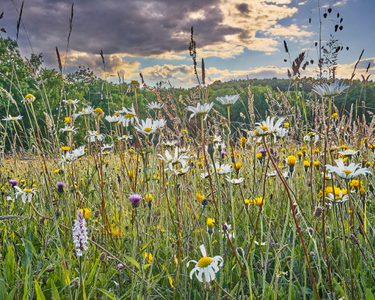How to grow flowers
How to create a wildflower area

You don’t need a large meadow to grow wild flowers. A corner of your lawn, a patch between your beds or on the edge of your allotment can all be converted to wild flower growing. However, the important thing is not to enrich the soil. Fertile soils in flower beds, with nutrients such as phosphates, will allow weeds such as nettles and docks to take over. A poor, well-drained, sunny patch is ideal.
Preparation – first dig out perennial weeds. If your soil is nutrient rich, take off the top 20 cms to expose a poorer subsoil. Then prepare a firm, level seedbed a month before you plan to sow. This allows the weed seeds to establish and you to hoe them off!
Sowing – the best time to sow is September, when the soil is still warm, this allows a cold period before germination in the spring. Sow sparingly. It helps to mix the seed thoroughly with sawdust or silver sand, so you can see where you have broadcast it. Then gently rake and firm the surface. Water if conditions are very dry.
Cutting – allow your flowers to set seed before mowing. Spring flowering meadows can be cut from late June onwards, a summer flowering meadow from September onwards. Do not cut the grass too short ie a minimum of 5 cms. Leaving the hay for a couple of weeks allows it to shed its seed, and then it must be removed to keep the soil fertility low.
Types of flowers - try to support traditional meadows and other grassland flowers by using native wildflower mixes. Many species, including quaking-grass, harebell, crosswort, wild strawberry, common rockrose, field scabious, hoary plantain, tormentil, ragged robin and devil's bit scabious, which were once widespread, are now on the Near Threatened list in England. A healthy wildflower meadow can host 140 species.
An elusive, but helpful plant in creating a wildflower meadow, is the attractive annual Yellow rattle. In the past this plant was a serious pest for farmers as it weakens grasses and as a result can reduce hay yields. In a planned wildflower meadow, however, this suppression of grass growth is welcomed. At the end of each growing season as the annual yellow rattle plants die away they leave behind gaps into which new wild flowers can establish. For a full factsheet on creating a wildflower meadow, login or sign up to become a member.